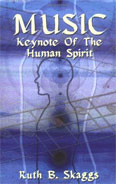 |
Music: Keynote of the Human Spirit by Ruth B. Skaggs PublishAmerica
book review by Karolina Blaha-Black
"Music is a natural bridge between conscious and unconscious worlds."
The quote above gives readers the gist of this eye-opening book on how music can heal, provide links to our primordial beginnings, act as an oracle, answer our lifes quandaries, and make us whole emotionally and physically. The author, an accomplished musician, a music teacher, and a psychotherapist delves deep into the usage of music and how it affects us on a physical and psychological level. In her words, music is a source of expanding consciousness beyond the everyday, personal world, to a state that embraces transpersonal and cosmic realms of experience. According to the author, as music has been a part of human development since times immemorial, it has the ability to lead us back to our human roots.
Using classical music in her research and in her psychotherapy sessions, Skaggs believes that more than any other type of music, classical music is the genre that embraces all of the psychic and emotional possibilities within a human. In several chapters, the book explores how music can serve as an oracle, it explains the various archetypes that music evokes from within our brain when listened to (some examples of archetypes are dualism, and the cycle of death and rebirth), how music can heal (when trying to alleviate pain, for example), and how music can aid those who are dying and how it can ease their passage from this world into the next. Particularly fascinating are her chapters on the messages that illness might bring or the images that people see when their death is near. Also worth mentioning is the section on chakras (energy centers located throughout the body), which includes a helpful chakra-balancing exercise.
Taking a scholarly approach to her subject and highlighting stories from real-life clients who attended her psychotherapy sessions, Skaggs' book is fascinating and her subject is worth further exploration. That is easily accomplished due to the handy reference section at the end of the book.
RECOMMENDED by the US Review
